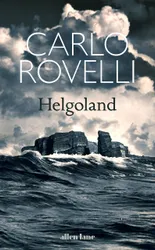This is a book about the strange world of quantum physics, and how we might make sense of the unintuitive things we’ve learned about the nature of the universe at the quantum level. In many ways, it’s not really a science book at all - it’s more philosophy - and Rovelli takes the opportunity for some speculative thinking on the nature of reality.
The Helgoland of the title is an island off the coast of Germany where Werner Heisenberg retreated in the 1920s in order to think about physics (and relieve his hay fever in a low pollen environment). The result was the matrix formulation of quantum mechanics, in which the properties (of an electron, for example) cannot be calculated exactly, and instead only observable properties have any meaning. The early part of the book covers the pioneers of quantum theory, including Niels Bohr, Werner Heisenberg and Erwin Schrödinger. Schrödinger’s contribution was the wave function, which was an attempt to make the weirdness of quantum mechanics more palatable by interpreting the behaviour of an electron as being a wave, just like other more familiar waves in physics. The book makes the case that this was a misunderstanding; the world really is as weird as quantum mechanics suggests, and the wave formulation is just another way of looking at Heisenberg’s matrices. It doesn’t tell us anything new, although it can be useful for calculating the probabilities of certain interactions, which is all that quantum mechanics allows us to do, rather than being able to determine and predict observable properties accurately.
The book covers several interpretations of quantum mechanics, including the ‘Many Worlds’, ‘Hidden Variables’ and ‘Physical Collapse’ interpretations, and makes the case that these all invent the existence of unverifiable and untestable mechanisms in order to make the weirdness go away. The ‘Copenhagen Interpretation’ isn’t mentioned at all, so I was unsure about how this fits into the theories presented here. Possibly the relational interpretation given by this book is an extension to and clarification of the Copenhagen Interpretation. But this wasn’t made clear in the book.
After these other interpretations, we come to the author’s case for a relational interpretation of quantum mechanics. I’m not sure I came away from the book with a clear enough understanding of this to be able to summarise it here! But it seemed to involve a few different ideas.
The first is that particles don’t actually exist. Only their interactions with each other exist, and reality is formed by the history of these interactions across space and time. One obvious question that wasn’t answered in the book was this: If we know that an electron had an interaction at a certain point in time and space, we might use quantum mechanics to work out the probability of some future interactions. We might not know exactly when and where the interaction takes place, but we can surely expect that the electron will interact somewhere, and when it does so, it will look and behave like an electron. If an electron really doesn’t exist between interactions with other particles, then what is it that keeps its ‘electronness’ between those interactions? I am probably horribly misunderstanding the theory in posing this question, but it would have been nice if the book had covered objections like this a bit more, even if just to point out why the question is invalid!
Another idea in this relational interpretation is to do with the idea of the ‘observer’. Particular clarification seems to be required around the role of the observer in quantum mechanics; what this word ‘observer’ actually means, and what counts as an observer. Schrödinger’s cat gets used here (although rather charmingly, the author does not want to kill the cat, and so a sleeping draft is used instead of deadlier measures in order to put the cat into one of two possible states). The book seems to be making the case that an observer could be any other particle involved in an interaction, and the idea of ‘entanglement’ is raised here to describe two particles that have interacted with each other and carry information about each other. A human and a cat could also be entangled in this way, where the entanglement means that the human now knows whether the cat is awake or asleep.
Towards the end of the book, Rovelli tackles consciousness from a quantum perspective. Normally quantum theorists are reluctant to tackle this topic, because there is a lot of pseudoscience along the lines of “consciousness is strange, quantum mechanics is strange, therefore there must be some deep connection between the two”. I’m not sure I really understood what Rovelli was saying in this part of the book. It seemed to be about how the mental models we hold about the world are entangled with the real world objects they represent. Perhaps an expansion of this idea might overlap with the ideas about consciousness in Being You.
If you want to feel like you understand quantum mechanics, I don’t think this is the right book for you. This area of physics is very confusing and uninutuitive (perhaps nobody really understands it), and while the author makes a good effort at explaining the relational interpretation, I certainly didn’t come away from this book with a good understanding! What this book does really well is convey the strangeness of the world described by quantum mechanics. Not understanding it is sort of the end goal of this book, and by that measure it definitely succeeds!
